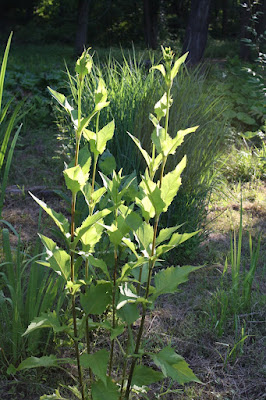 I've had six walnut logs since a tree fell two years ago. I painted them red, and I've been trying to find a use for them. A vague memory of a magazine photo showing a corridor lined with red logs at Jack Lenor Larson's garden on Long Island (seen many years ago) kept recurring. He had used them in a Japanese context. For me, in a western New Jersey forest habitat, red evokes the Native Americans who lived in this area for thousands of years - the Lenni Lenape. I put them into a circle (think symbol of turning inward for protection, a group huddled around a campfire) under cedar trees at a far side of the garden and, last weekend, repainted them Front Door Red. They work well viewed from a distance through the plantings.
I've had six walnut logs since a tree fell two years ago. I painted them red, and I've been trying to find a use for them. A vague memory of a magazine photo showing a corridor lined with red logs at Jack Lenor Larson's garden on Long Island (seen many years ago) kept recurring. He had used them in a Japanese context. For me, in a western New Jersey forest habitat, red evokes the Native Americans who lived in this area for thousands of years - the Lenni Lenape. I put them into a circle (think symbol of turning inward for protection, a group huddled around a campfire) under cedar trees at a far side of the garden and, last weekend, repainted them Front Door Red. They work well viewed from a distance through the plantings.You can't see them here, but they are to the right of the tallest cedar in the center of the photo.
 Here you see a glimpse of red but you may need to click on the photo to enlarge it.
Here you see a glimpse of red but you may need to click on the photo to enlarge it. Changing viewpoint slightly ...
Changing viewpoint slightly ... A little closer, standing amid the plants ...
A little closer, standing amid the plants ... As long as we're standing here, a close-up of backlighting on a Silphium perfoliatum shown from distance above ...
As long as we're standing here, a close-up of backlighting on a Silphium perfoliatum shown from distance above ... Getting closer ...
Getting closer ... Shifting viewpoint again ...
Shifting viewpoint again ... Red of a different sort, Lysimachia ciliata 'Firecracker'. It was vertical, but continuous rain has given it a graceful quashed look, though it's covering most of the path.
Red of a different sort, Lysimachia ciliata 'Firecracker'. It was vertical, but continuous rain has given it a graceful quashed look, though it's covering most of the path. Viewed from the opposite side ...
Viewed from the opposite side ... And at greater distance, moving toward the logs, which are behind the photographer ...
And at greater distance, moving toward the logs, which are behind the photographer ... Panning right toward the bank at the base of the house ...
Panning right toward the bank at the base of the house ... Up close, the logs look naked. They need additional plantings, perhaps small bunch grasses or carex and other smaller plants to anchor them and make them appear to have grown out of the earth.
Up close, the logs look naked. They need additional plantings, perhaps small bunch grasses or carex and other smaller plants to anchor them and make them appear to have grown out of the earth.
You know, that's actually quie ineresting. I think some carex or somthing would be geat--oviously something with loose, dynamic foliage to contrast with the stolid wood... though red makes it appear in motion, or alight, or something.
ReplyDeleteI'd like to use Sporobolis heterolepsis but it's probably too wet. Maybe Deschampsia cespitosa, or some of the Japanese carexes, or a form of Hakone grass.
ReplyDeleteThis is terrific and very native American if not Stonehenge is suggested. Red is perfect. Bronze carex or even something with a large leaf for textural contrast. Hmmm, Podophyllum peltatum, Mayapple comes to mind.
ReplyDeleteFrances at Fairegarden
It's a surprising effect, discovering the emphatic color and sense of geometry set among your looser plantings. Frances' comment about Stonehenge is interesting. The geometry to me suggests some sort of sundial or observatory--maybe an observatory for the seasons.
ReplyDeleteI've got some Sporobolis heterolepsis out front in the clay they back filled the house with. A little sandy, but frankly just sticky clay. I never water that bed (which holds a weeping white birch which loves it there so far), and yet it never gets dry. It isn't soaking wet, but certainly stays damp. I did top dress with city compost and lots of woodchips, though.
ReplyDeleteFrances, Mayapples sound perfect in appearance but probably not practical for this location. It can get more heat later in the day than Podophyllum like - at least the ones native here. But the image I like a lot.
ReplyDeleteJames, a sundial or observatory ... I like that too. The impulse to need a sundial, to create the concept of a sundial out of need and a flash of insight, or through practiced, slow observation. Various metaphoric paths here.
ReplyDeleteBenjamin, maybe it's worth giving sporobolis h. a try. But it takes so many years to develop a fine plume. (complain)
ReplyDelete